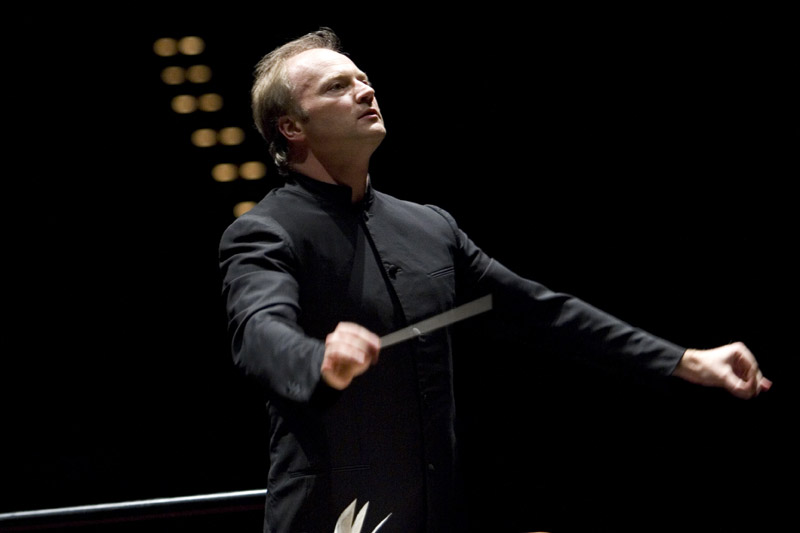Benedetti, LSO, Noseda, Barbican review – power and focus | reviews, news & interviews
Benedetti, LSO, Noseda, Barbican review – power and focus
Benedetti, LSO, Noseda, Barbican review – power and focus
Dark-hued intensity in compelling Shostakovich programme

Shostakovich is ideal for Nicola Benedetti. His music requires effortless and understated virtuosity, as well as a confident and commanding maturity of interpretation. Benedetti has been demonstrating these qualities since her late teens, and all were evident in this reading of the First Violin Concerto, which proved an intense and compelling listening experience.
In the opening Nocturne, Benedetti dug heavily into the strings, bringing an intense physicality to her tone. Sometimes she pushed too hard, leading to voicing issues and jarring breaks. But that intensity continued, even as Benedetti relaxed her bow arm to bring a rounder warmth to the tone. The arching structure of this first movement was elegantly described in Benedetti’s broad phasing, creating a single line of melody, gradually growing in intensity, and never losing focus or concentration.
From the second movement, it was clear that conductor Gianandrea Noseda (pictured below) was on the violinist’s wavelength, drawing similar intensity from the orchestra. The playing here was positively lurid, with Benedetti taking a lead from the frenetic tuned percussion in each of the maniacal dance episodes. Noseda also tried to open the Passacaglia third movement with similar weight, but some poor ensemble in the first statements of the bass theme meant that the dark mood took a little longer to establish. But it was firmly in place when Benedetti entered, initially seeming to support her high cantilena lines, but gradually taking on a more sinister and oppressive edge as the solo line turned lonely and introspective.
The cadenza introduction to the finale felt like a brief moment of release, though even here Shostakovich’s demons are never far from the surface, given voice in Benedetti’s dark-toned virtuosity. In the finale, the orchestra grows in confidence and weight, vying with the soloist for the spotlight. Noseda again drew bold and dynamic energy, especially from the woodwind soloists, but Benedetti held her ground, her virtuoso roulades dominating the coda, even across the incisive rhythms of the full orchestra.  After many years under Valery Gergiev, the London Symphony is now a well-oiled machine for Shostakovich symphonies, so Gianandrea Noseda could be forgiven for deferring to their expertise. But that’s not his way, and his Tenth Symphony was characterised by a very different approach to phrasing. At the opening, for example, the short phrases that make up the main theme in the low strings were distinct, all separated by clear silences. Yet his approach to the overall structure was as unified and coherent as Benedetti’s in the concerto. As the dynamics grew, he was always in control of the emotional temperature, the build-up not just a simple crescendo, but a complex interaction of constraint and release. The sheer weight of the LSO’s string sound is a huge asset in Shostakovich, and Noseda knows how to marshal it. In the first movement, a warm bed of sonorous strings supported a series of woodwind solos, beginning with the clarinet. But each soloist contrasts the stability of that string sound with a sense of fragility; the authoritarian mass against the vulnerable individual.
After many years under Valery Gergiev, the London Symphony is now a well-oiled machine for Shostakovich symphonies, so Gianandrea Noseda could be forgiven for deferring to their expertise. But that’s not his way, and his Tenth Symphony was characterised by a very different approach to phrasing. At the opening, for example, the short phrases that make up the main theme in the low strings were distinct, all separated by clear silences. Yet his approach to the overall structure was as unified and coherent as Benedetti’s in the concerto. As the dynamics grew, he was always in control of the emotional temperature, the build-up not just a simple crescendo, but a complex interaction of constraint and release. The sheer weight of the LSO’s string sound is a huge asset in Shostakovich, and Noseda knows how to marshal it. In the first movement, a warm bed of sonorous strings supported a series of woodwind solos, beginning with the clarinet. But each soloist contrasts the stability of that string sound with a sense of fragility; the authoritarian mass against the vulnerable individual.
The emphatic down-bow unison rhythms in the second movement were genuinely terrifying, this another dimension of the LSO’s string sound perfectly suited to Shostakovich. Noseda drove these tuttis with a manic energy of his own, each note hammered out as a downbeat from both arms, the rest of his body shaking from the intensity of the action. He can maintain this for minutes on end, for the climaxes of both the outer movements and for the whole of the Scherzo. It looks exhausting, but it energises the players and maintains the intensity.
The third and fourth movements are characterised by a reflective passages from the solo woodwinds, often leading into further frenetic climaxes. Again in the third movement, and especially in the opening of the fourth, the soloists gave that feeling of fragility and isolation in the face of the orchestra’s potential violence, a psychological effect given all the more power by Noseda’s ability to make the orchestral outburst unpredictable, looming crescendos either interrupted, or wholly illusory. That’s as much a theatrical effect as musical, and Noseda has the intuitive sense of drama to bring it off. Just one of the many qualities he brings to make the Noseda/LSO combination a near-perfect fit for Shostakovich.
- The performance of Shostakovich’s Tenth Symphony from this concert can be watched online at: https://www.youtube.com/watch?v=fXUIbQWdXhc
- Nicola Benedetti will perform Shostakovich’s First Violin Concerto with the City of Birmingham Symphony Orchestra on 27 and 28 June. For more information, please visit: https://cbso.co.uk/event/nicola-benedetti-shostakovich
rating
Explore topics
Share this article
The future of Arts Journalism
You can stop theartsdesk.com closing!
We urgently need financing to survive. Our fundraising drive has thus far raised £49,000 but we need to reach £100,000 or we will be forced to close. Please contribute here: https://gofund.me/c3f6033d
And if you can forward this information to anyone who might assist, we’d be grateful.

Subscribe to theartsdesk.com
Thank you for continuing to read our work on theartsdesk.com. For unlimited access to every article in its entirety, including our archive of more than 15,000 pieces, we're asking for £5 per month or £40 per year. We feel it's a very good deal, and hope you do too.
To take a subscription now simply click here.
And if you're looking for that extra gift for a friend or family member, why not treat them to a theartsdesk.com gift subscription?
more Classical music
 BBC Proms: Liu, Philharmonia, Rouvali review - fine-tuned Tchaikovsky epic
Sounds perfectly finessed in a colourful cornucopia
BBC Proms: Liu, Philharmonia, Rouvali review - fine-tuned Tchaikovsky epic
Sounds perfectly finessed in a colourful cornucopia
 BBC Proms: Suor Angelica, LSO, Pappano review - earthly passion, heavenly grief
A Sister to remember blesses Puccini's convent tragedy
BBC Proms: Suor Angelica, LSO, Pappano review - earthly passion, heavenly grief
A Sister to remember blesses Puccini's convent tragedy
 BBC Proms: A Mass of Life, BBCSO, Elder review - a subtle guide to Delius's Nietzschean masterpiece
Mark Elder held back from blasting the audience with a wall of sound
BBC Proms: A Mass of Life, BBCSO, Elder review - a subtle guide to Delius's Nietzschean masterpiece
Mark Elder held back from blasting the audience with a wall of sound
 BBC Proms: Le Concert Spirituel, Niquet review - super-sized polyphonic rarities
Monumental works don't quite make for monumental sounds in the Royal Albert Hall
BBC Proms: Le Concert Spirituel, Niquet review - super-sized polyphonic rarities
Monumental works don't quite make for monumental sounds in the Royal Albert Hall
 Frang, Romaniw, Liverman, LSO, Pappano, Edinburgh International Festival 2025 review - sunlight, salt spray, Sea Symphony
Full force of the midday sea in the Usher Hall, thanks to the best captain at the helm
Frang, Romaniw, Liverman, LSO, Pappano, Edinburgh International Festival 2025 review - sunlight, salt spray, Sea Symphony
Full force of the midday sea in the Usher Hall, thanks to the best captain at the helm
 Elschenbroich, Grynyuk / Fibonacci Quartet, Edinburgh International Festival 2025 review - mahogany Brahms and explosive Janáček
String partnerships demonstrate brilliant listening as well as first rate playing
Elschenbroich, Grynyuk / Fibonacci Quartet, Edinburgh International Festival 2025 review - mahogany Brahms and explosive Janáček
String partnerships demonstrate brilliant listening as well as first rate playing
 BBC Proms: Akhmetshina, LPO, Gardner review - liquid luxuries
First-class service on an ocean-going programme
BBC Proms: Akhmetshina, LPO, Gardner review - liquid luxuries
First-class service on an ocean-going programme
 Budapest Festival Orchestra, Iván Fischer, Edinburgh International Festival 2025 review - mania and menuets
The Hungarians bring dance music to Edinburgh, but Fischer’s pastiche falls flat
Budapest Festival Orchestra, Iván Fischer, Edinburgh International Festival 2025 review - mania and menuets
The Hungarians bring dance music to Edinburgh, but Fischer’s pastiche falls flat
 Classical CDs: Hamlet, harps and haiku
Epic romantic symphonies, unaccompanied choral music and a bold string quartet's response to rising sea levels
Classical CDs: Hamlet, harps and haiku
Epic romantic symphonies, unaccompanied choral music and a bold string quartet's response to rising sea levels
 Kolesnikov, Tsoy / Liu, NCPA Orchestra, Chung, Edinburgh International Festival 2025 review - transfigured playing and heavenly desire
Three star pianists work wonders, and an orchestra dazzles, at least on the surface
Kolesnikov, Tsoy / Liu, NCPA Orchestra, Chung, Edinburgh International Festival 2025 review - transfigured playing and heavenly desire
Three star pianists work wonders, and an orchestra dazzles, at least on the surface
 BBC Proms: Láng, Cser, Budapest Festival Orchestra, Iván Fischer review - idiomatic inflections
Bartók’s heart of darkness follows Beethoven’s dancing light
BBC Proms: Láng, Cser, Budapest Festival Orchestra, Iván Fischer review - idiomatic inflections
Bartók’s heart of darkness follows Beethoven’s dancing light

Add comment